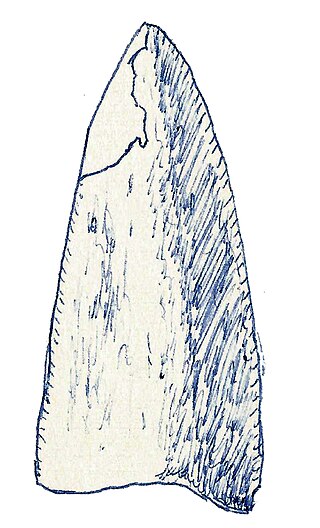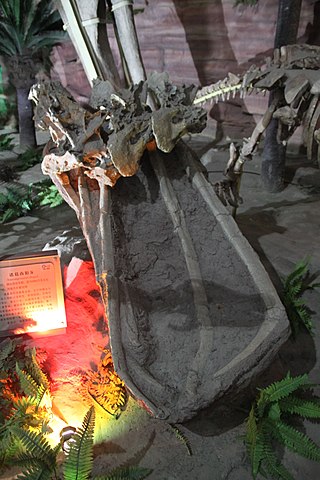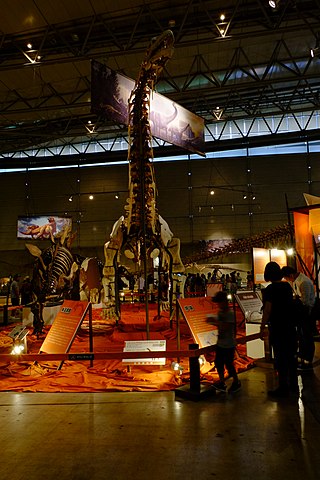
Titanosaurs were a diverse group of sauropod dinosaurs, including genera from all seven continents. The titanosaurs were the last surviving group of long-necked sauropods, with taxa still thriving at the time of the extinction event at the end of the Cretaceous. This group includes some of the largest land animals known to have ever existed, such as Patagotitan—estimated at 37 m (121 ft) long with a weight of 69 tonnes —and the comparably-sized Argentinosaurus and Puertasaurus from the same region.

Antarctosaurus is a genus of titanosaurian sauropod dinosaur from the Late Cretaceous Period of what is now South America. The type species, Antarctosaurus wichmannianus, and a second species, Antarctosaurus giganteus, were described by prolific German paleontologist Friedrich von Huene in 1929. Three additional species of Antarctosaurus have been named since then but later studies have considered them dubious or unlikely to pertain to the genus.

Bonitasaura is a genus of titanosaurian dinosaur hailing from uppermost layers of the Late Cretaceous (Santonian) Bajo de la Carpa Formation, Neuquén Group of the eastern Neuquén Basin, located in Río Negro Province, Northwestern Patagonia, Argentina. The remains, consisting of a partial sub-adult skeleton jumbled in a small area of fluvial sandstone, including a lower jaw with teeth, a partial vertebrae series, and limb bones, were described by Sebastian Apesteguía in 2004.

Ampelosaurus is a titanosaurian sauropod dinosaur from the Late Cretaceous Period of what is now France. Its type species is A. atacis, named by Le Loeuff in 1995. Its remains were found in a level dating from 71.5 million years ago representing the early Maastrichtian.

Epachthosaurus was a genus of titanosaurian sauropod dinosaur from the Late Cretaceous. It was a basal lithostrotian titanosaur. Its fossils have been found in Central and Northern Patagonia in South America.
Gobititan is a genus of herbivorous sauropod dinosaur from the Aptian faunal stage of the Early Cretaceous. The name of this genus is derived from the Gobi desert region and the Titans of Greek mythology, which is a reference to its large body size. The specific name shenzhouensis, is derived from "Shenzhou", an ancient name for China.

Mongolosaurus is a genus of titanosauriform sauropod dinosaur which lived during the Early Cretaceous of China.

Sonidosaurus is a genus of sauropod dinosaur from the Late Cretaceous. It was a titanosaur which lived in what is now Inner Mongolia. The type species, Sonidosaurus saihangaobiensis, was described by Xu, Zhang, Tan, Zhao, and Tan in 2006. It was a small titanosaur, about 9 meters (30 ft) long. It was first discovered in the Iren Dabasu Formation in 2001 in a quarry which would later yield the remains of Gigantoraptor starting in 2005.

Saltasauridae is a family of armored herbivorous sauropods from the Upper Cretaceous. They are known from fossils found in South America, Africa, Asia, North America, and Europe. They are characterized by their vertebrae and feet, which are similar to those of Saltasaurus, the first of the group to be discovered and the source of the name. The last and largest of the group and only one found in North America, Alamosaurus, was thirty-four metres in length and one of the last sauropods to go extinct.

Lithostrotia is a clade of derived titanosaur sauropods that lived during the Early Cretaceous and Late Cretaceous. The group was defined by Upchurch et al. in 2004 as the most recent common ancestor of Malawisaurus and Saltasaurus and all the descendants of that ancestor. Lithostrotia is derived from the Ancient Greek lithostros, meaning "inlaid with stones", referring to the fact that many known lithostrotians are preserved with osteoderms. However, osteoderms are not a distinguishing feature of the group, as the two noted by Unchurch et al. include caudal vertebrae with strongly concave front faces (procoely), although the farthest vertebrae are not procoelous.
The Sunjiawan Formation is a geological formation in Liaoning, China, with strata possibly dating back to the early Late Cretaceous, specifically the Cenomanian. Dinosaur remains are among the fossils that have been recovered from the formation. It forms part of the same geological sequence as the older and underlying Yixian Formation and Jiufotang Formation. It primarily consists of variegated conglomerates with rare intercalations of thin bedded sandstones, siltstones and mudstones.

Baotianmansaurus is a genus of titanosaur sauropod dinosaur. Its fossils have been found in Upper Cretaceous rocks in Henan, China, within the Gaogou Formation. The type species is B. henanensis, described in 2009. The holotype is 41H III-0200. Remains of the fossils were vertebrae, ribs and scapula fragments. It was probably a close relative of Opisthocoelicaudia and Dongyangosaurus in Saltasauridae.

Xianshanosaurus is a genus of sauropod dinosaur from the Early Cretaceous (Aptian-Albian) of the Ruyang Basin in Henan Province, China. Its type and only species is Xianshanosaurus shijiagouensis. It was described in 2009 by a team of paleontologists led by Lü Junchang. Xianshanosaurus may be a titanosaur, and Daxiatitan may be its closest relative, but its evolutionary relationships remain controversial.

Yongjinglong is an extinct genus of titanosauriform sauropod dinosaur known from the Early Cretaceous of Lanzhou-Minhe Basin of Gansu Province, China. It contains a single species, Yongjinglong datangi.
Tengrisaurus is a genus of lithostrotian sauropod, from the Early Cretaceous (Barremian-Aptian) Murtoi Formation, Russia. It was described in 2017 by Averianov & Skutschas. The type species is T. starkovi. New remains were described in 2021 by Averianov, Sizov & Skutschas.

Sibirotitan is a genus of somphospondyl sauropod from the Ilek Formation of Russia. The type and only species is S. astrosacralis.

Volgatitan is a genus of titanosaurian sauropod dinosaur from the Early Cretaceous of the Ulyanovsk Oblast, Russia. The type and only species is Volgatitan simbirskiensis, known from seven caudal vertebrae from a single individual. It is the oldest known titanosaur from the northern hemisphere, and is considered important for being related to the Lognkosauria, a group known only from South America later in the Late Cretaceous. It was first described in November 2018 by Russian palaeontologists Alexander Averianov and Vladimir Efimov. It is estimated to have weighed about 17.3 metric tons.

Abdarainurus is a genus of titanosaur dinosaur from the Alagteeg Formation in Mongolia. The type and only species is A. barsboldi. Currently seen as an indeterminate titanosaur, it may represent a previously unknown lineage of Asian macronarians. Abdarainurus is not known from many remains; it is only known from eight front tail vertebrae and a middle tail vertebra and several chevrons.

Dzharatitanis is a genus of sauropod from the Bissekty Formation in Uzbekistan, dating to the Turonian age of the Late Cretaceous. The genus contains a single species, Dzharatitanis kingi, named after geologist Christopher King, who contributed to the Cretaceous geology of Asia. It is currently one of two known sauropods from the Bissekty Formation, alongside an indeterminate titanosaur. In its original publication it was considered to be a member of Rebbachisauridae, but later papers considered it to be a titanosaur.

Gandititan is an extinct genus of titanosaurian sauropod dinosaur from the Late Cretaceous Zhoutian Formation of China. The genus contains a single species, G. cavocaudatus, known from a partial skeleton.



























